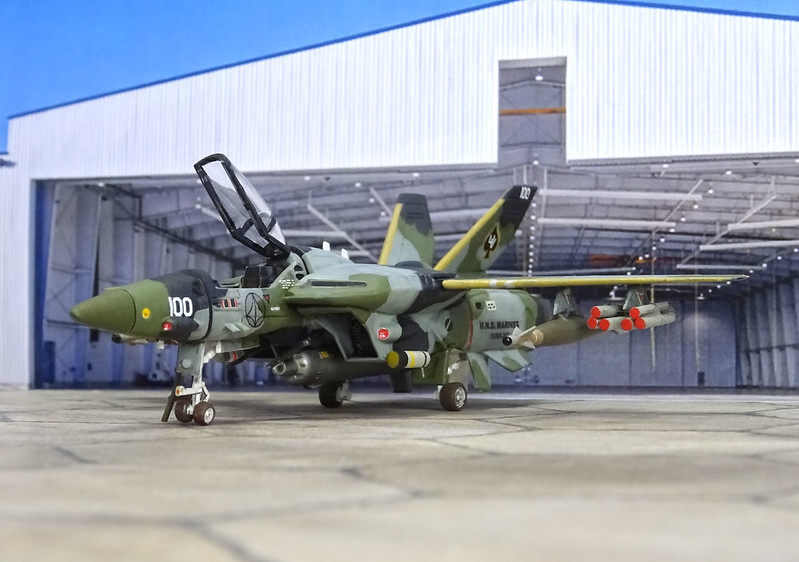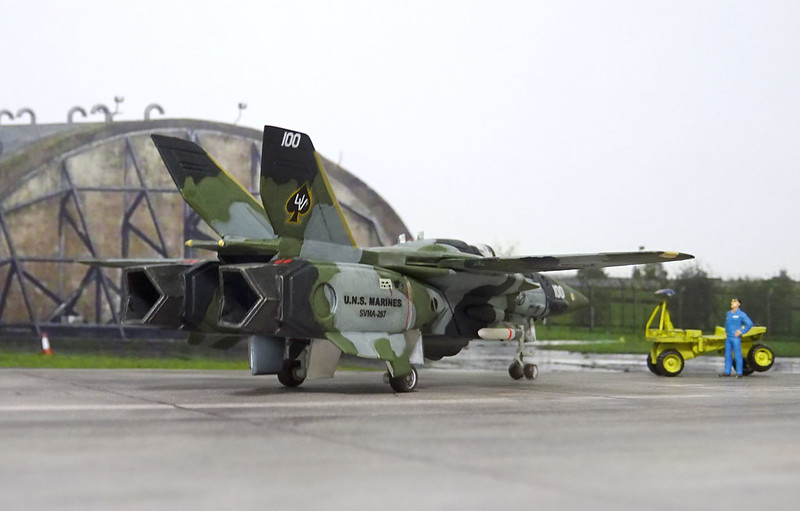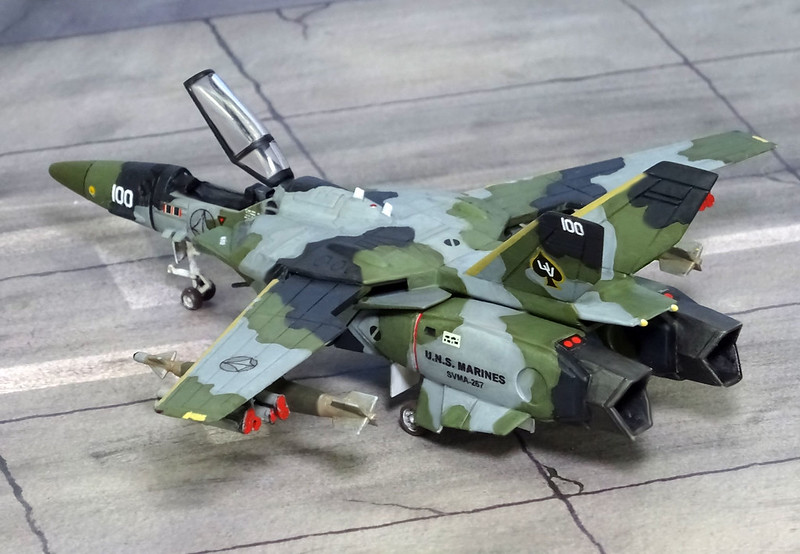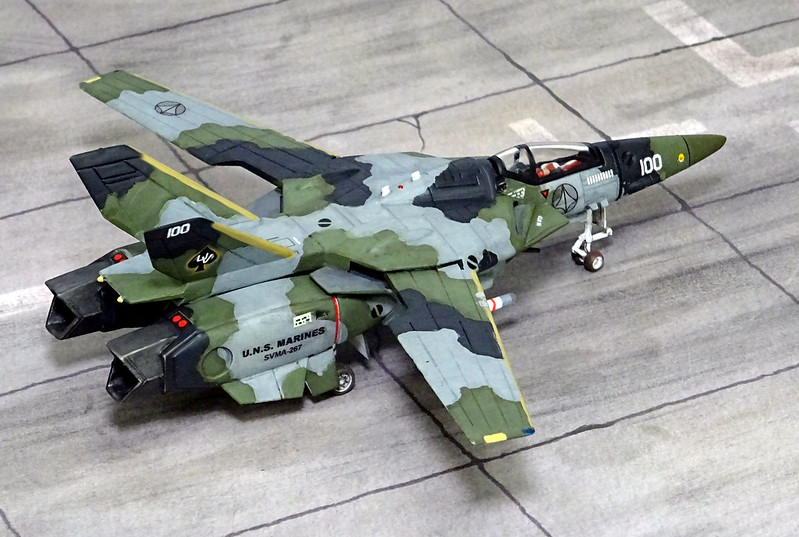Nach einer Weile eine weitere klassische ARII VF-1 im Fighter-Modus – allerdings ein What-if-Modell. Es gibt viele quasi-realistische und sogar kanonische UNSMC-Walküren da draußen – aber ich habe keine in der attraktiven dreifarbigen Cammo des USMC gesehen.

 Hintergrund:The VF-1 was developed by Stonewell/Bellcom/Shinnakasu for the U.N. Spacy by using alien Overtechnology obtained from the SDF-1 Macross alien spaceship. Its production was preceded by an aerodynamic proving version of its airframe, the VF-X. Unlike all later VF vehicles, the VF-X was strictly a jet aircraft, built to demonstrate that a jet fighter with the features necessary to convert to Battroid mode was aerodynamically feasible. After the VF-X's testing was finished, an advanced concept atmospheric-only prototype, the VF-0 Phoenix, was flight-tested from 2005 to 2007 and briefly served as an active-duty fighter from 2007 to the VF-1's rollout in late 2008, while the bugs were being worked out of the full-up VF-1 prototype (VF-X-1).
Hintergrund:The VF-1 was developed by Stonewell/Bellcom/Shinnakasu for the U.N. Spacy by using alien Overtechnology obtained from the SDF-1 Macross alien spaceship. Its production was preceded by an aerodynamic proving version of its airframe, the VF-X. Unlike all later VF vehicles, the VF-X was strictly a jet aircraft, built to demonstrate that a jet fighter with the features necessary to convert to Battroid mode was aerodynamically feasible. After the VF-X's testing was finished, an advanced concept atmospheric-only prototype, the VF-0 Phoenix, was flight-tested from 2005 to 2007 and briefly served as an active-duty fighter from 2007 to the VF-1's rollout in late 2008, while the bugs were being worked out of the full-up VF-1 prototype (VF-X-1).
The space-capable VF-1's combat debut was on February 7, 2009, during the Battle of South Ataria Island - the first battle of Space War I - and remained the mainstay fighter of the U.N. Spacy for the entire conflict. Introduced in 2008, the VF-1 would be out of frontline service just five years later, though.



The VF-1 proved to be an extremely capable craft, successfully combating a variety of Zentraedi mecha even in most sorties which saw UN Spacy forces significantly outnumbered. The versatility of the Valkyrie design enabled the variable fighter to act as both large-scale infantry and as air/space superiority fighter. The signature skills of U.N. Spacy ace pilot Maximilian Jenius exemplified the effectiveness of the variable systems as he near-constantly transformed the Valkyrie in battle to seize advantages of each mode as combat conditions changed from moment to moment.
The basic VF-1 was deployed in four sub-variants (designated A, D, J, and S) and its success was increased by continued development of various enhancements including the GBP-1S "Armored" Valkyrie, FAST Pack "Super" Valkyrie and the additional RÖ-X2 heavy cannon pack weapon system for the VF-1S for additional firepower. The FAST Pack system was designed to enhance the VF-1 Valkyrie variable fighter, and the initial V1.0 came in the form of conformal pallets that could be attached to the fighter’s leg flanks for additional fuel – primarily for Long Range Interdiction tasks in atmospheric environment. Later FAST Packs were designed for space operations.
After the end of Space War I, the VF-1 continued to be manufactured both in the Sol system and throughout the UNG space colonies. Although the VF-1 would be replaced in 2020 as the primary Variable Fighter of the U.N. Spacy by the more capable, but also much bigger, VF-4 Lightning III, a long service record and continued production after the war proved the lasting worth of the design.



The versatile aircraft underwent constant upgrade programs. For instance, about a third of all VF-1 Valkyries were upgraded with Infrared Search and Track (IRST) systems from 2016 onwards, placed in a streamlined fairing in front of the cockpit. This system allowed for long-range search and track modes, freeing the pilot from the need to give away his position with active radar emissions, and it could also be used for target illumination and guiding precision weapons.
Many Valkyries also received improved radar warning systems, with sensor arrays, depending on the systems, mounted on the wing-tips, on the fins and/or on the LERXs. Improved ECR measures were also added to some machines, typically in conformal fairings on the flanks of the legs/engine pods.
The U.N.S. Marine Corps, which evolved from the United States Marine Corps after the national service was transferred to the global U.N. Spacy command in 2008, was a late adopter of the VF-1, because the Valkyries’ as well as the Destroids’ potential for landing operations was underestimated. But especially the VF-1’s versatility and VTOL capabilities made it a perfect candidate as a replacement for the service’s AV-8B Harrier II and AH-1 Cobra fleet in the close air support (CAS) and interdiction role. The first VF-1s were taken into service in January 2010 by SVMF-49 “Vikings” at Miramar Air Base in California/USA, and other units followed soon, immediately joining the battle against the Zentraedi forces.
The UNSMC’s VF-1s were almost identical to the standard Valkyries, but they had from the start additional hardpoints for light loads like sensor pods added to their upper legs, on the lower corners of the air intake ducts. These were intended to carry FLIR, laser target designators (for respective guided smart weapons) or ECM pods, while freeing the swiveling underwing hardpoints to offensive ordnance.
Insisting on their independent heritage, the UNSMC’s Valkyries were never repainted in the U.N. Spacy’s standard tan and white livery. They either received a unique two tone low visibility gray paint scheme (the fighter units) or retained paint schemes that were typical for their former units, including some all-field green machines or VF-1s in a disruptive wraparound livery in grey, green and black.
Beyond A and J single-seaters (the UNSMC did not receive the premium S variant), a handful of VF-1D two-seaters were upgraded to the UNSMC’s specification and very effectively operated in the FAC (Forward Air Control) role, guiding both long-range artillery as well as attack aircraft against enemy positions.



The UNSMC’s VF-1s suffered heavy losses, though – for instance, SVMF-49 was completely wiped out during the so-called “Zentraedi Rain of Death” in April 2011, when the Zentraedi Imperial Grand Fleet, consisting of nearly five million warships, appeared in orbit around the Earth. Commanded by Dolza, Supreme Commander of the Zentraedi, they were ordered to incinerate the planet's surface, which they did. 70% of the Earth was utterly destroyed, according to the staff at Alaska Base. Dolza initially believed this to be total victory, until a massive energy pulse began to form on the Earth's surface. This was the Grand Cannon, a weapon of incredible destructive power that the Zentraedi were unaware of, and it disintegrated a good deal of the armada that was hanging over the Northern Hemisphere. While the Zentraedi were successful in rendering the weapon inoperable before it could fire a second time, the SDF-1 began a counterattack of its own alongside the renegade Imperial-Class Fleet and Seventh Mechanized Space Division, which destroyed the Imperial Grand Fleet. After this event, though, the UNSMC as well as other still independent services like the U.N. Navy were dissolved and the respective units integrated into the all-encompassing U.N. Spacy. Around this time, the VF-1s' standard livery was furthermore changed from whiet/tan to an all-over light grey, even though many units retained their colorful markings and higher-ranking pilots insisted on individual paint schemes for their mounts.
The VF-1 was without doubt the most recognizable variable fighter of Space War I and was seen as a vibrant symbol of the U.N. Spacy even into the first year of the New Era 0001 in 2013. At the end of 2015 the final rollout of the VF-1 was celebrated at a special ceremony, commemorating this most famous of variable fighters. The VF-1 Valkryie was built from 2006 to 2013 with a total production of 5,459 VF-1 variable fighters with several variants (VF-1A = 5,093, VF-1D = 85, VF-1J = 49, VF-1S = 30, VF-1G = 12, VE-1 = 122, VT-1 = 68)
However, the fighter remained active in many second line units and continued to show its worthiness years later, e. g. through Milia Jenius who would use her old VF-1 fighter in defense of the colonization fleet - 35 years after the type's service introduction!




Ein spontanes Interimsprojekt - und die dreifarbige USMC-Lackierung m.E. passt gut zur VF-1, die für diesen Dienst und seine Missionsprofile ein sehr geeignetes Flugzeug gewesen sein könnte. Ich bin mir allerdings immer noch etwas unsicher über die Wirksamkeit der Tarnung - ja, sie bricht die Silhouette auf, aber die Farbkontraste sind so hoch, dass es kaum einen Versteck-Effekt gibt, obwohl ich finde, dass das Schema auf städtischem Gelände gut funktioniert? Das Schema ist jedoch fiktiv, und obwohl es kanonische U.N.S. Marines VF-1s in der Literatur zu finden gibt, bin ich bisher keiner begegnet, die dieses Schema trug.

Mehr über das Modell und die Bauphase gibt es hier:
https://www.sfmforum.de/index.php/topic,43262.msg288374.html#msg288374